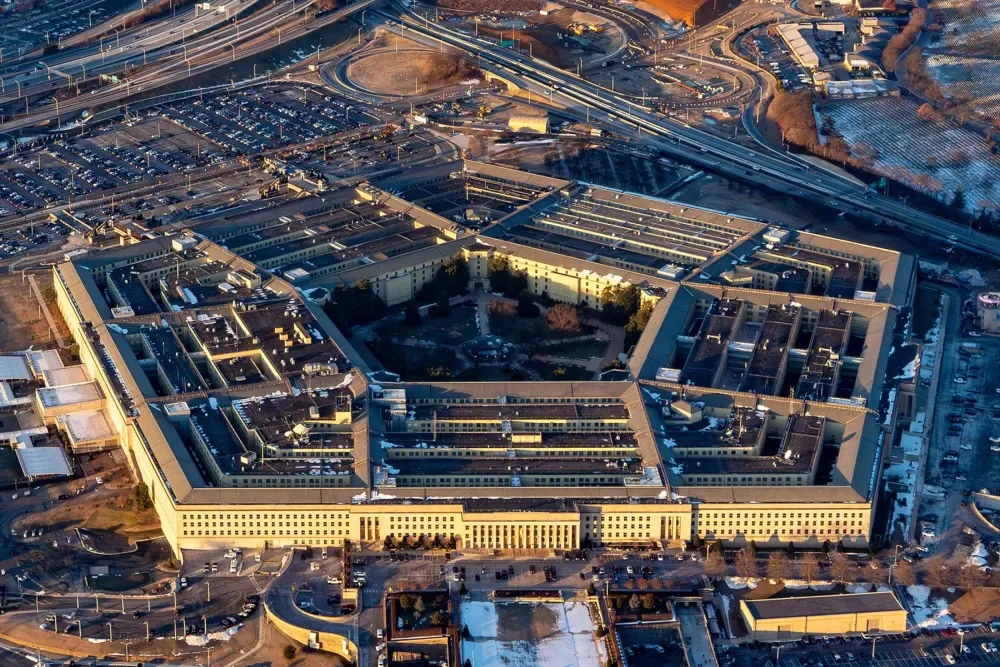Pentagon FY26 Offsets: A Briefing on All 17 Protected Categories
Executive Summary: The $50 Billion Realignment
Secretary of Defense Pete Hegseth's February 18, 2025 directive to reallocate $50 billion (8%) from the Biden administration's FY26 defense budget marks the most significant Pentagon budget restructuring since sequestration. The review targets "low-impact Biden-legacy programs" while protecting 17 priority categories aligned with the Trump administration's "America First" defense strategy. With a headline goal of achieving the first trillion-dollar defense budget ($1.01 trillion including reconciliation), the actual base budget shows minimal growth at $892.6 billion, relying heavily on $113 billion in reconciliation funding. This intelligence briefing provides comprehensive analysis of all 17 protected categories based on current 2024-2025 developments.
Category 1: Southwest Border Activities
Current Program Status
The Pentagon's border mission has transformed from minimal involvement to a centerpiece of defense priorities. Anduril Industries has deployed over 300 Autonomous Surveillance Towers (ASTs) along the southern border, achieving approximately 30% coverage and detecting hundreds of thousands of border crossings. The Big Bend Sector reported a 58.4% reduction in migrant encounters following AST deployment.
Funding Developments
- FY25 Allocation: $766 million for "cutting-edge border security technology"
- AST Program: $204 million earmarked for continued expansion
- IST/CTSE Contracts (2024):
- Elbit America: $23.9 million
- Advanced Technology Systems Company: $23.4 million
- General Dynamics One Source: $20.5 million
Key Contractors
- Anduril Industries: Primary AST contractor with $2+ billion valuation
- General Dynamics Information Technology: RVSS-U program (10+ years)
- Elbit America: Israeli defense giant's US subsidiary
Congressional Action
House Budget Committee proposed up to $300 billion in new border security funding. Senator Katie Britt's WALL Act seeks $25 billion for border wall completion.
Category 2: Combating Transnational Criminal Organizations
Current Status
SOUTHCOM's counter-TCO operations span from California to Puerto Rico, targeting Mexican cartels, MS-13, and Iran-backed Hezbollah operations. Admiral Craig S. Faller emphasizes big data/AI approaches for network disruption.
Funding Allocations
- DOD Counter-Drug Activities FY25: $913 million
- Defense Security Cooperation Agency FY25: $382 million
- Expected FY26 Increase: Significant boost under Trump priorities
Key Operations
- Operation Caribbean Guard: CBIG capability assessments
- Operation Citadel: HSI multinational smuggling interdiction
- HOMECORT Process: Criminal organization targeting prioritization
Category 3: Audit
FY24 Audit Results
The Pentagon received its seventh consecutive disclaimer of opinion, though progress indicators show improvement:
- Material Weaknesses: 46% increase in issues addressed vs FY23
- Clean Opinions: 9 of 28 reporting entities achieved unmodified opinions
- Fund Balance: 82% of DOD funding free of material weaknesses
- Audit Cost: $178 million for FY24 execution
Key Developments
- Defense Threat Reduction Agency achieved first-ever clean opinion
- Increased use of AI platforms to accelerate progress
- Legal deadline for clean audit by fiscal 2028
Category 4: Nuclear Modernization (including NC3)
Sentinel ICBM Crisis
- Cost Overrun: $140.9 billion total (81% increase from $96 billion baseline)
- Per-Unit Cost: $162 million (37% increase)
- Schedule Slip: 3+ years delayed
- Contractor: Northrop Grumman (sole source)
- Status: Nunn-McCurdy certification granted July 2024
B-21 Raider Progress
- Production: ~40 aircraft in various stages across two lots
- LRIP Approval: January 2024 milestone achieved
- Contractor Losses: Northrop Grumman reports $2+ billion in inflation losses
- IOC Target: Mid-2020s
Columbia-Class Delays
- Lead Ship: USS District of Columbia delayed 12-16 months to October 2028
- Program Cost: $130 billion for 12 submarines
- Contractor: General Dynamics Electric Boat performance shortfalls
NC3 Modernization
- SAOC Contract: Sierra Nevada Corp awarded April 2024
- ESS Budget: $1 billion FY25 request, IOC 2032
- E-6B Upgrades: $775 million TACAMO modernization
Category 5: Collaborative Combat Aircraft (CCAs)
Program Milestones
- April 24, 2024: Anduril and General Atomics selected for Increment 1
- Aircraft Designations: YFQ-42A (GA), YFQ-44A "Fury" (Anduril)
- First Flights: Summer 2025 scheduled
- Unit Cost Target: ~$30 million per aircraft
Contract Values
- FY25 Request: $577.1 million
- Total Program: $8.9 billion through FY29
- Planned Procurement: 1,000-2,000 CCAs through mid-2030s
Industry Competition
Boeing, Lockheed Martin, and Northrop Grumman eliminated but remain eligible for production contracts at own expense.
Category 6: Virginia-Class Submarines
Production Crisis
- Current Rate: ~1.2-1.3 boats/year (below 2/year target)
- April 30, 2024 Award: $18.5 billion to GDEB ($17.1B) and HII ($1.3B)
- Ships: USS Baltimore (SSN-812) and USS Atlanta (SSN-813)
- Block V Features: 84-foot VPM with 28 additional VLS cells
Industrial Base Challenges
- Severe skilled worker deficits at both yards
- 20% cost growth from labor increases
- Virginia-class boats running ~3 years behind schedule
- AUKUS requirement for 2.33 boats/year strains capacity
Category 7: Executable Surface Ships
DDG(X) Development
- Timeline: Construction begins 2032, delivery 2035+
- Cost: $3.2-4.4 billion per ship
- Features: IPS, directed energy weapons, 96+ VLS cells
- Design Changes: Removed Mark 45 gun, new VLS layout
Constellation-Class Crisis
- Lead Ship Delay: 36 months to 2027-2029
- Completion: Only 10% complete as of April 2025
- Root Causes: Design immaturity, workforce shortages
- Contractor: Fincantieri Marinette Marine
Category 8: Homeland Missile Defense
Next Generation Interceptor
- Major Award: Lockheed Martin selected April 2024
- Program Value: $17.7 billion total
- IOC Target: Q4 FY2028, potentially accelerated to 2027
- Initial Procurement: 20 interceptors at $74+ million each
Golden Dome Initiative
- Executive Order: January 27, 2025
- Funding: $25 billion in reconciliation
- Leadership: Gen. Michael Guetlein (Space Force)
- Scope: Scale Iron Dome "400 times over"
Category 9: One-Way Attack/Autonomous Systems
Replicator Progress
- Funding: $1 billion across FY24-25
- Industry Engagement: 500+ companies, 30+ contracts
- Confirmed Systems: Switchblade-600, Anduril Dive-LD
- Production Goal: Thousands of systems within 18-24 months
DIU Acceleration
- FY24 Budget: $983 million (up from ~$180M)
- Contract Authority: 60-90 day awards via OTA
- Strategy: DIU 3.0 scaling commercial technologies
Category 10: Counter-small UAS Initiatives
Coyote Interceptor Expansion
- January 2024: RTX awarded $75 million for 600 Coyote 2C
- September 2024: Additional $197 million contract
- Production Requirements: 6,000 kinetic, 700 non-kinetic interceptors
- Unit Cost: $100,000-$200,000 per interceptor
VAMPIRE Success
- Ukraine Deployment: 14 systems proving effective against Shahed-136
- Configuration: L3Harris sensor with BAE APKWS rockets
- Platform: Vehicle-agnostic, container-based options
Category 11: Priority Critical Cybersecurity
Zero Trust Implementation
- Target Date: FY2027 deadline maintained
- Portfolio Office: 15+ pilots planned for FY24-25
- JADC2 Integration: Critical for data sharing across domains
- Thunderdome: DISA initiative extended with Booz Allen Hamilton
Category 12: Munitions
155mm Artillery Revolution
- Pre-Ukraine: 14,000 rounds/month
- October 2024: 40,000 rounds/month achieved
- October 2025 Target: 100,000 rounds/month (1.2M annually)
- New Facilities: Texas plant using Turkish technology
GMLRS/HIMARS Scaling
- HIMARS Production: 96 units/year by 2024
- GMLRS Capacity: 14,000 units/year target
- ER-GMLRS: 150km range variant starting 2025
Category 13: Core Readiness (Full DRT Funding)
Protected Funding
- Status: Full Defense Readiness Test funding explicitly protected
- FY25 RDT&E: $141 billion approved
- Service Allocations:
- Army: $14.3 billion
- Navy: $26 billion
- Air Force: $46.8 billion
- Space Force: $18.6 billion
Category 14: Munitions and Energetics Organic Industrial Base
15-Year Modernization Plan
- Total Investment Needed: $14-16 billion through 2035
- Already Invested: $5 billion since 2009
- Average Facility Age: 58 years (8 years beyond service life)
Solid Rocket Motor Expansion
- L3Harris Aerojet: $215.6 million DPA agreement
- Production Increase: 60% growth to 115,000 motors/year
- New Partnership: Lockheed-General Dynamics third source
Category 15: Executable INDOPACOM MILCON
Major Projects
- Tinian Divert Airfield: $384 million, 50% complete
- North Field Restoration: $409 million to Fluor Corp
- Guam Munitions Storage: $43 million for 20 new igloos
- Yap Airfield: $400 million planned investment
PDI Funding Gap
- FY25 Request: $9.9 billion
- INDOPACOM Need: $26.5 billion annually
- Gap: $11 billion in unfunded priorities
Category 16: Combatant Command Support Agency Funding
Protected Commands
- INDOPACOM: $124 million for Mission Network
- NORTHCOM: $35 million unfunded priority
- SPACECOM: Strong support for $3.5 billion request
- STRATCOM: Nuclear deterrence coordination
- CYBERCOM: Pacific operations support
- TRANSCOM: Theater logistics coordination
Notable Exclusions
EUCOM, AFRICOM, CENTCOM, SOUTHCOM not protected from cuts.
Category 17: Medical Private-Sector Care
T-5 TRICARE Transition
- Humana Military (East): $70.8 billion over 9 years
- TriWest (West): $65.1 billion over 9 years
- Total Value: $136 billion (longest contracts in history)
- Beneficiaries: 9.6 million across all regions
Budget Allocations
- Total MHS: $61.4 billion FY25
- Defense Health Program: $40.3 billion
- Cost Growth: 2-3% annually vs 8% commercial
Contractor Opportunities and Industrial Base Implications
Winners of the Offsets
- Anduril Industries: Border surveillance, CCAs, autonomous systems
- General Atomics: CCA winner, drone dominance
- Lockheed Martin: NGI sole source, munitions expansion
- RTX (Raytheon): Counter-UAS, Patriot production
- L3Harris: Solid rocket motors, counter-drone systems
Industrial Base Challenges
- Shipbuilding capacity crisis threatens submarine and surface ship goals
- Munitions production requires $14-16 billion infrastructure investment
- Workforce shortages across all sectors
- Supply chain vulnerabilities in energetics and semiconductors
Congressional and Policy Developments
Key Congressional Actions
- Reconciliation Package: $150 billion over 4 years, $113 billion in FY26
- Senate Criticism: Wicker calls budget "material neglect" despite trillion-dollar headline
- House Support: 215-214 passage of reconciliation bill
Policy Shifts
- Border security elevated to core defense mission
- Climate programs eliminated entirely
- DEI initiatives terminated
- Geographic rebalancing toward Pacific and homeland
Market Intel for Defense Industry
Strategic Recommendations
- Pivot to Protected Categories: Align portfolios with 17 exempt areas
- Autonomous Systems: Major growth in unmanned/AI capabilities
- Munitions Surge: Historic expansion opportunity
- Border Technology: New market with sustained funding
- Nuclear Modernization: Despite overruns, funding protected
Risk Factors
- F-35 not protected, potential cuts ahead
- European programs vulnerable
- Traditional platforms under pressure
- Climate/sustainability contracts at risk
Investment Outlook
The FY26 offset review creates clear winners and losers in defense contracting. Companies aligned with border security, autonomous systems, munitions production, and Pacific infrastructure stand to benefit significantly. Traditional platform providers and European-focused contractors face headwinds. The emphasis on "transformation" over sustainment suggests a generational shift in Pentagon procurement priorities, accelerated by lessons from Ukraine and great power competition with China.
The Pentagon's budget reimagination represents not just a funding reallocation but a fundamental strategic pivot toward homeland defense, unmanned systems, and industrial base expansion while accepting risk in traditional power projection capabilities.






